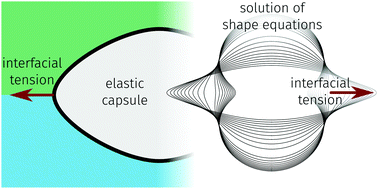当前位置:
X-MOL 学术
›
Soft Matter
›
论文详情
Our official English website, www.x-mol.net, welcomes your
feedback! (Note: you will need to create a separate account there.)
Elastic capsules at liquid–liquid interfaces
Soft Matter ( IF 2.9 ) Pub Date : 2018-06-08 00:00:00 , DOI: 10.1039/c8sm00316e Jonas Hegemann 1, 2, 3, 4 , Horst-Holger Boltz 4, 5, 6 , Jan Kierfeld 1, 2, 3, 4
Soft Matter ( IF 2.9 ) Pub Date : 2018-06-08 00:00:00 , DOI: 10.1039/c8sm00316e Jonas Hegemann 1, 2, 3, 4 , Horst-Holger Boltz 4, 5, 6 , Jan Kierfeld 1, 2, 3, 4
Affiliation

|
We investigate the deformation of elastic microcapsules adsorbed at liquid–liquid interfaces. An initially spherical elastic capsule at a liquid–liquid interface undergoes circumferential stretching due to the liquid–liquid surface tension and becomes lens- or discus-shaped, depending on its bending rigidity. The resulting elastic capsule deformation is qualitatively similar, but distinct from the deformation of a liquid droplet into a liquid lens at a liquid–liquid interface. We discuss the deformed shapes of droplets and capsules adsorbed at liquid–liquid interfaces for a whole range of different surface elasticities: from droplets (only surface tension) deforming into liquid lenses, droplets with a Hookean membrane (finite stretching modulus, zero bending modulus) deforming into elastic lenses, to microcapsules (finite stretching and bending modulus) deforming into rounded elastic lenses. We calculate capsule shapes at liquid–liquid interfaces numerically using shape equations from nonlinear elastic shell theory. Finally, we present theoretical results for the contact angle (or the capsule height) and the maximal capsule curvature at the three phase contact line. These results can be used to infer information about the elastic moduli from optical measurements. During capsule deformation into a lens-like shape, surface energy of the liquid–liquid interface is converted into elastic energy of the capsule shell giving rise to an overall adsorption energy gain by deformation. Soft hollow capsules exhibit a pronounced increase of the adsorption energy as compared to filled soft particles and, thus, are attractive candidates as foam and emulsion stabilizers.
中文翻译:

液-液界面处的弹性胶囊
我们研究了吸附在液-液界面的弹性微胶囊的变形。最初处于液-液界面的球形弹性囊由于液-液表面张力而受到周向拉伸,并根据其抗弯刚度变为透镜或铁饼形。所产生的弹性胶囊变形在质量上相似,但不同于液滴在液-液界面处变形为液状透镜的变形。我们讨论了液滴和胶囊在液-液界面处吸附的变形形状,具有各种不同的表面弹性:从液滴(仅表面张力)变形为液体晶状体,带有厚膜的液滴(有限的拉伸模量,零弯曲模量)变形为弹性镜片,微囊(有限的拉伸和弯曲模量)变形为圆形弹性透镜。我们使用非线性弹性壳理论中的形状方程式,通过数值计算液-液界面处的胶囊形状。最后,我们给出了三相接触线上的接触角(或胶囊高度)和最大胶囊曲率的理论结果。这些结果可用于从光学测量中推断出有关弹性模量的信息。在胶囊变形为透镜状的过程中,液-液界面的表面能转换为胶囊壳的弹性能,从而通过变形获得整体吸附能。与填充的软颗粒相比,中空的软胶囊显示出明显的吸附能增加,因此,
更新日期:2018-06-08
中文翻译:

液-液界面处的弹性胶囊
我们研究了吸附在液-液界面的弹性微胶囊的变形。最初处于液-液界面的球形弹性囊由于液-液表面张力而受到周向拉伸,并根据其抗弯刚度变为透镜或铁饼形。所产生的弹性胶囊变形在质量上相似,但不同于液滴在液-液界面处变形为液状透镜的变形。我们讨论了液滴和胶囊在液-液界面处吸附的变形形状,具有各种不同的表面弹性:从液滴(仅表面张力)变形为液体晶状体,带有厚膜的液滴(有限的拉伸模量,零弯曲模量)变形为弹性镜片,微囊(有限的拉伸和弯曲模量)变形为圆形弹性透镜。我们使用非线性弹性壳理论中的形状方程式,通过数值计算液-液界面处的胶囊形状。最后,我们给出了三相接触线上的接触角(或胶囊高度)和最大胶囊曲率的理论结果。这些结果可用于从光学测量中推断出有关弹性模量的信息。在胶囊变形为透镜状的过程中,液-液界面的表面能转换为胶囊壳的弹性能,从而通过变形获得整体吸附能。与填充的软颗粒相比,中空的软胶囊显示出明显的吸附能增加,因此,











































 京公网安备 11010802027423号
京公网安备 11010802027423号